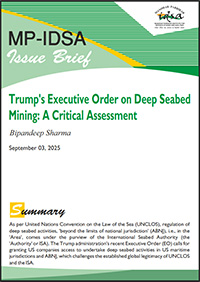Trump’s Executive Order on Deep Seabed Mining: A Critical Assessment
- September 03, 2025 |
- Issue Brief
Summary
As per United Nations Convention on the Law of the Sea (UNCLOS), regulation of deep seabed activities, ‘beyond the limits of national jurisdiction’ (ABNJ), i.e., in the ‘Area’, comes under the purview of the International Seabed Authority (the ‘Authority’ or ISA). The Trump administration’s recent Executive Order (EO) calls for granting US companies access to undertake deep seabed activities in US maritime jurisdictions and ABNJ, which challenges the established global legitimacy of UNCLOS and the ISA.
Introduction
Critical minerals are an integral component of states’ economic and national security. Control over these (both reserves and supply chains) plays a significant role in determining Comprehensive National Power. Primarily, minerals such as Copper, Cobalt, Lead, Manganese, Nickel, Silicate, Zinc and others are finding their growing uses in the manufacture of chips, semiconductors, batteries, wind and solar panels. They are crucial for military and emerging critical technologies. The extraction and supply chain of such minerals can become vulnerable due to several factors. States become natural custodian of such minerals if these are available within their respective national territorial and maritime jurisdictions. The discovery and future possibilities of extracting these minerals in deep-sea spaces, especially in maritime ‘areas beyond national jurisdiction’ (ABNJ), have garnered global attention.
A new Executive Order (EO) signed by US President Donald J. Trump on 24 April 2025 calls for enabling US access to vast reserves of mineral resources on the deep seabed space. Trump’s EO emphasises that concerned US State departments, acting in accordance with the United States’ domestic Deep Seabed Hard Mineral Resources Act (DSHMRA), can grant US companies the required permission to undertake deep seabed exploration and exploitation activities in US maritime jurisdictions, as well as in ABNJ. The EO further emphasises that the US seeks reliable supplies of critical minerals that currently remain in control of its adversaries, which can pose significant challenges to US economic and national security interests.[1] On the one hand, Trump’s EO seeks to strengthen further the US’s existing positions about the United Nations Convention on the Law of the Sea (UNCLOS), while on the other, it challenges established international frameworks of deep seabed exploration and exploitation.
Deep Seabed Spaces: Regulation and Control
UNCLOS is the fundamental instrument that regulates global maritime spaces. Globally, 170 countries have signed and ratified the UNCLOS, whereas 14 UN member states have signed but have not ratified this convention. States have the legitimate authority to regulate deep seabed activities within their national maritime jurisdictions, however, regulation of deep seabed activities, ‘beyond the limits of national jurisdiction’, i.e., in the ‘Area’, comes under the purview of the International Seabed Authority (the ‘Authority’ or ISA) as established by UNCLOS.[2] All activities in the ‘Area’ are governed and regulated as per Part XI of UNCLOS and the 1994 Agreement relating to its implementation.[3] As per Article 156 of UNCLOS, all state parties are ipso facto members of the ISA. The decision-making process within the ISA is based on consensus. ISA has approved 31 applications submitted by 22 countries/companies to undertake deep-seabed minerals exploration activities in the ‘Area’.[4] The ISA has not yet issued any exploitation rights for deep seabed resources, as it is still developing the necessary regulatory framework for states to undertake deep seabed mining in the ‘Area’.
US Executive Order: Critical Aspects
The US, to date, remains a non-party to UNCLOS, but has signed the 1994 agreement. Trump’s EO calls for strengthening US capabilities in exploration, characterisation, collection and processing of seabed minerals and seeks investments in deep-sea science. Trump’s EO calls upon the US Secretary of Commerce to “expedite the process for reviewing and issuing seabed mineral exploration licenses and commercial recovery permits in areas beyond national jurisdiction under the Deep Seabed Hard Mineral Resources Act (DSHMRA) (30 U.S.C. 1401 et seq.), consistent with applicable law”.[5]
The US Congress passed the DSHMRA in 1980 as an ‘interim measure’ which allowed US citizens and companies to proceed with seabed mining activities in the ABNJ, ‘until an international regime was in place’, i.e., the UNCLOS.[6] Without any existing global mechanism, DSHMRA established a framework for authorising US citizens and corporations to explore and recover minerals from the seabed in ABNJ. Acting through this, the United States’ National Oceanic and Atmospheric Administration (NOAA) in 1984 issued four exploration licenses to a US-led consortium for four sites in areas beyond US jurisdiction. These four licenses were issued for 10 years, before UNCLOS entered into force and 12 years before the ISA became operational. Since 1984 and the post-UNCLOS provisions coming into force, the NOAA has not issued any new exploration licenses apart from approving extension requests.[7] This sudden move by the Trump administration, therefore, raises serious concerns.
Legal scholars argue that since the US has not ratified UNCLOS and is not bound by treaty law, it has every right to proceed with deep-seabed mining, even in international waters, as per its domestic legislation.[8] The existence of DSHMRA is also a potential reason why the US has not become a party to UNCLOS and ISA.
However, others within the US argue that Part XI on seabed mining “could still be binding as customary international law for the United States” despite the US’s non-ratification of UNCLOS.[9] They argue that if the US remains a non-ratifying party to UNCLOS, US citizens issued licenses or permits by NOAA as per its DSHMRA would have no legal recourse under UNCLOS mechanisms to protect their claim to explore and/or recover seabed minerals in the ‘Area’.[10] Further, according to the ISA, parties to UNCLOS have “a duty not to recognise any claim, acquisition, or exercise of rights over minerals recovered from the ‘Area’ by any State or by any natural or juridical person, unless conducted in accordance with Part XI of UNCLOS”.[11]
Secondly, the US decision to grant access to American companies in the ‘Area’ raises the critical question of ‘benefit sharing’. However, Trump’s EO has called for a report on the “feasibility of an international benefit-sharing mechanism for seabed mineral resource extraction and development that occurs in the areas beyond the national jurisdiction of any country”. How this matches US interests, and what practical measures the US takes in this regard, is difficult to assess.
It is, however, worth mentioning that the debates within the US on seabed mining and on the clause of ‘benefit sharing’ as established by Part XI of UNCLOS and the 1994 Agreement date back to several decades.[12] For instance, President Ronald Reagan, in his radio address titled ‘Ocean Mining’, in 1978, asserted: “No nat(ional) interest of ours could justify handing sovereign control of two-thirds of the Earth’s surface over to the Third World”. He added:
“No one has ruled out the idea of a (Law of the Sea) treaty — one which makes sense — but after long years of fruitless negotiating, it became apparent that the underdeveloped nations who now control the General Assembly were looking for a free ride at our expense, again.”[13]
After coming to power, Reagan made every attempt to dilute these provisions of deep-seabed mining and retained the US position of not signing the treaty. Historical inferences, therefore, point to the fact that President Trump’s EO, while remaining aligned with its past policy approach and existing domestic legislation, re-attempts to dilute/bypass/challenge established provisions of UNCLOS to cater to the US’s national interests.
Thirdly, China currently holds five exploration licenses (two in the Northwest Pacific Ocean, two in the Clarion-Clipperton Zone, and one in the Indian Ocean Region) granted to it by the ISA. China also remains at the forefront of the race for critical minerals and their global supply chains and is even further ahead in mapping and exploring these in deep-sea space. Western scholars argue that China even makes significant ‘financial contributions’ to the ISA, which helps China influence the ISA’s decision-making.[14]
China, for its part, claims that all its exploration activities in the deep seabed spaces remain within the purview of established international law and fully adhere to the ISA regulations. Chinese scholars argue that China advocates multilateral frameworks anchored in UNCLOS and managed by the ISA for deep-seabed mining. China’s foreign ministry has condemned Trump’s EO by highlighting that it “violates international law and harms the overall interests of the international community”.[15]
Fourth, global aspirations to harness the existing potential of deep-seabed resources are already high, and these are bound to increase in the future. Through its member states, the ISA is working extensively to reach a consensus on finalising the ‘Mining Code’ that would lay the ground rules for exploiting deep-seabed resources. Discussion over mechanisms for equitable sharing of profits among ISA member states from these future activities is also under consideration.[16] The ISA Secretary-General, in her formal response to Trump’s EO, has highlighted that
“As one might imagine, the level of legal complexity of such work cannot be denied. Any negotiations where 169 countries are involved, and where foundational concepts such as ‘common heritage’ and global ‘benefit sharing’ are being implemented, with many interests at stake, but overall, dealing with a common good which belongs to all, will never be easy; and this is precisely why the advancement of the exploitation regulations and the Mining Code are taking time for countries to develop, and agree.”[17]
Trump’s EO amidst ongoing ISA negotiations could raise new challenges. In a scenario, if the US NOAA, acting in accordance with its DSHMRA, issues exploration or exploitation rights to any US company in the ‘Area’, and if such designated area overlaps with the exploration or exploitation area of another state, as approved by the ISA or vice versa, it could potentially trigger geopolitical reactions and responses. Under such circumstances, it remains a moot question if ISA member states (some of whom are also close US allies) would compromise their national interests or would be able to reach a consensus with the US company, acting in accordance with US domestic legislation in the ‘Area’.
Finally, the formal exit of the US from the Paris Agreement has limited global progress made over commitments towards the UN Sustainable Development Goals (SDGs).[18] Any unilateral action towards deep-seabed resources exploitation, without giving due consideration to SDGs, brings into question the US and its global commitments towards United Nations Sustainable Development Goal No. 14.[19] From environmental and ocean ecological perspectives, the prospects of deep-seabed mining are yet to be fully realised, and there remain significant research gaps in this domain. The US’s approach of providing fast-track access to its own private companies to exploit deep-seabed minerals poses serious risks to the global ocean ecosystem. While the EO highlights that the US wants to proceed with deep-seabed mining without compromising on environmental aspects, how this would pan out remains debatable.
In June 2023, the biodiversity in ABNJ (BBNJ agreement) or the ‘High Sea Treaty’ was concluded and is currently open for signatures and ratification.[20] Around 139 nations have signed the BBNJ agreement, and 52 countries have ratified it. This treaty can only come into force 120 days after the formal ratification by 60 states. Like UNCLOS, the US is a signatory to the BBNJ, but has yet to ratify the ‘High Seas Treaty’. Implementation of key aspects of BBNJ in areas of deep seabed exploitation authorised via domestic legislations, such as DSHMRA (if in future), could create geopolitical complexities for states and international bodies.
Conclusion
Deep-seabed mining continues to remain a controversial subject. Member states of the ISA are seeking a common consensus to regulate deep-seabed exploitation and are drafting mechanisms for equitable benefit sharing. States that foresee exploitation of deep-seabed mining in the future are in early stages of developing infrastructural and technological capabilities and are undertaking exploration activities. At the same time, others strongly oppose the concept as a whole. Trump’s EO, on one hand, creates easy pathways for US seabed mining companies, which for a long time have been struggling to become pioneers in deep seabed mining, while on the other, challenges UNCLOS and ISA, and brings into question the hard-earned consensus on various aspects that would formulate the basis of the Mining Code in future.
Trump’s EO, which claims to counter China’s aggressive approach in seabed mining, instead highlights the US’s own attempts to establish the dominance of US seabed mining companies in its own and areas beyond its national jurisdiction, without fully realising the potential environmental and ecological implications on the ocean ecosystem. Implementing this order within the US maritime jurisdiction could benefit US seabed mining companies. However, granting of licenses for undertaking deep seabed exploration or commercial recovery permits in the ABNJ by US authorities would challenge and dilute the established global legitimacy of UNCLOS (especially for those states that remain signatory to it), the 1994 agreement and that of ISA as a whole. Such an order risks challenging the credibility and faith in established international multilateral institutions and would set a dangerous precedent for future global ocean governance.
[1] “Unleashing America’s Offshore Critical Minerals and Resources”, Executive Order, The White House, 24 April 2025.
[2] “United Nations Convention on the Law of the Sea (UNCLOS)”, United Nations, 10 December 1982.
[3] “Agreement Relating to the Implementation of Part XI of the United Nations Convention on the Law of the Sea of 10 December 1982”, Division for Ocean Affairs and Law of the Sea, United Nations, 28 July 1994.
[4] “Exploration Contracts”, International Seabed Authority, 31 January 2024.
[5] “Unleashing America’s Offshore Critical Minerals and Resources”, no. 1.
[6] “Deep Seabed Hard Mineral Resources Act”, United States, 28 June 1980; “U.S. Interest in Seabed Mining in Areas Beyond National Jurisdiction: Brief Background and Recent Developments”, Congressional Research Service, 25 April 2025.
[7] Ibid.
[8] James Kraska, “The U.S. Executive Order on Seabed Mining is Consistent with International Law”, International Law Studies, Vol. 106, 2025.
[9] Adelaide Miller, Peter de Kruijff and Lucy Cooper, “Trump’s Deep-sea Mining Executive Order Sparks Condemnation by Scientists and Conservationists”, ABC News, 2 May 2025.
[10] Caitlin Keating-Bitonti, “Seabed Mining in Areas Beyond National Jurisdiction: Issues for Congress”, Library of Congress, 15 July 2025; “Statement on United States Actions Concerning the Conference on the Law of the Sea”, Archives, Ronald Reagan Presidential Library and Museum, 9 July 1982.
[11] Caitlin Keating-Bitonti, “Seabed Mining in Areas Beyond National Jurisdiction: Issues for Congress”, no. 10.
[12] Ibid.
[13] The Hon. Edwin Meese III, “Law of the Sea Treaty No Better Today Than During Reagan Years”, The Heritage Foundation, 7 June 2012.
[14] Sally Yozell, “Race to the Deep on Seabed Mining”, Stimson Center, 19 November 2024.
[15] Max Bearak, “China Says Trump’s Order on Seabed Mining Violates International Law”, The New York Times, 25 April 2025.
[16] “The Mining Code”, International Seabed Authority, 31 January 2024.
[17] Leticia Reis de Carvalho, “Statement on the US Executive Order: ‘Unleashing America’s Offshore Critical Minerals and Resources’”, Secretary-General of the International Seabed Authority, Kingston, Jamaica, 30 April 2025.
[18] Taylor Pullins and Suzanne Knijnenburg, “US Withdrawal from the Paris Agreement: Impact and Next Steps”, White & Case, 21 January 2025.
[19] “Goal 14: Conserve and Sustainably Use the Oceans, Seas and Marine Resources”, United Nations Sustainable Development Goals, 1 January 2016.
[20] “Agreement Under the United Nations Convention on the Law of the Sea on the Conservation and Sustainable Use of Marine Biological Diversity of Areas Beyond National Jurisdiction”, United Nations, 2023.






